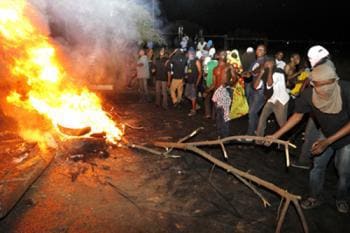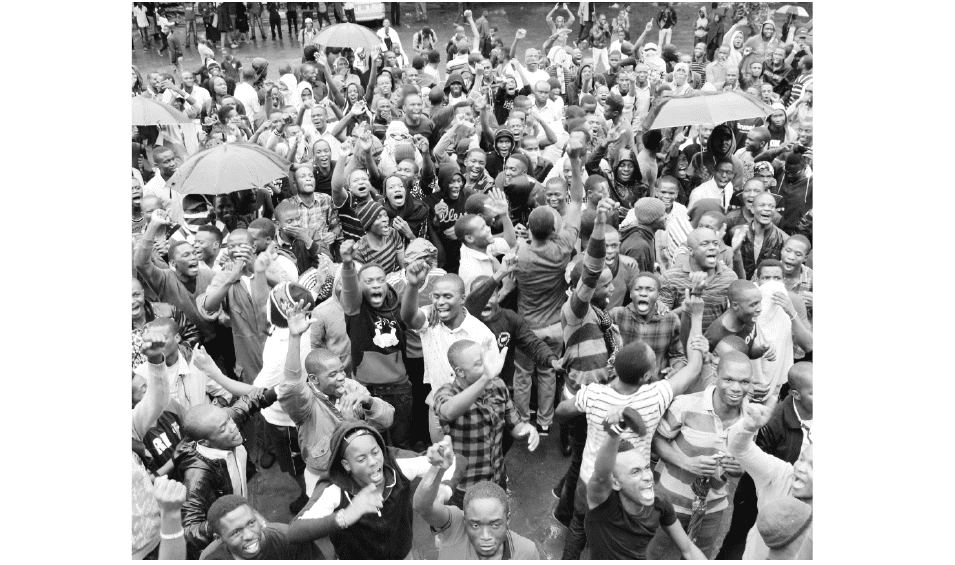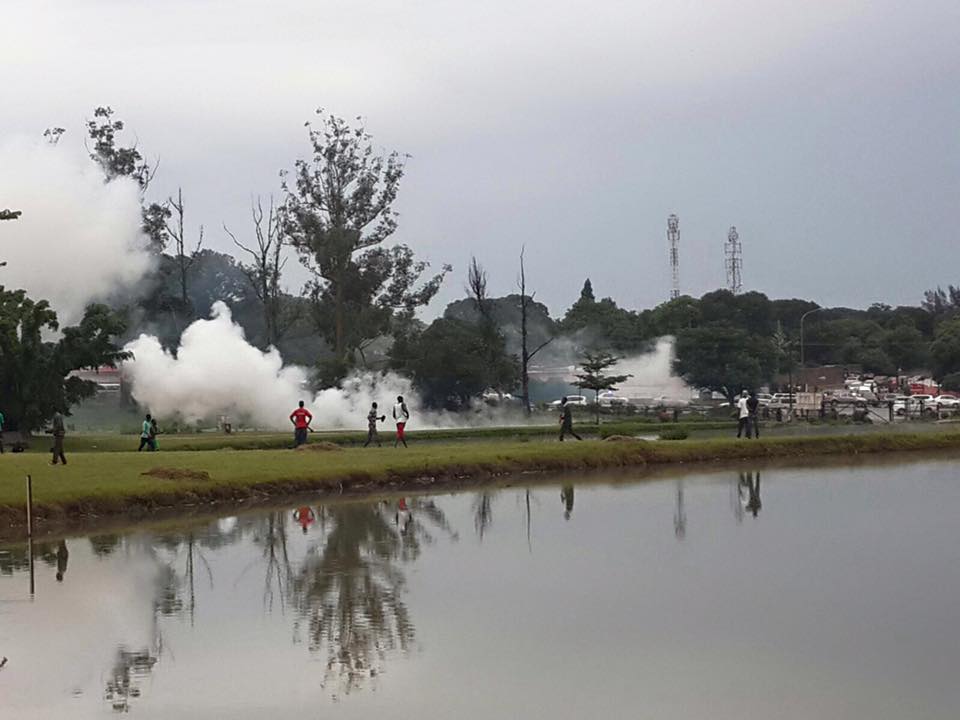Invariably, the centre for student demonstrations, University of Zambia (UNZA) ‘Monk’ Square has come to be a symbol and an echo of student power at times of tension in the nation and on campus.
The University of Zambia has with its graduates spread across the breadth and width of the country in both the public and private sector, asserting itself very well as Zambia’s premier university. Despite this elevated status it enjoys, not to mention the prestige and power it carries, UNZA frequently attracts media attention often on the wrong side of things; caught up in destruction of private property on the Great East Road.
Surrounded by no buildings or walls, but, naturally, four-cornered, and accessible by stairways located on two of its sides, the Monk Square does not, just like its sister square ‘Mature’, enjoy the most complete definition of a square. It was inaugurated in 1966. The square had not been a venue for student indabas until the 1980s when it replaced the Graduation Forum for this purpose.

The word ‘Monk’ has been in the UNZA dictionary since the institution’s early days. Having its antonym as Moma, that is, any female student, the usual sense of the word has been extended to refer to the ruins as an academic monastery that accommodates male students who, at the taste of academic cleansing, have conceived unbridled aversion for the sensual pleasures university social life has to offer.
Initially, the Ruins had been home to both male and female students. However, moral concerns, underpinned by revelations of sexual harassment and a frequency of unwanted pregnancies prompted the construction of separate hostels for female students. Dissolution of this arrangement catapulted the Ruins and the square towards Monk identity.
When Monk Square won, due to its proximity to the Ruins, as the ideal venue for ad hoc meetings addressing the welfare of students, its profile started being written.
As a rule, the factor that affects the welfare of students is delay, whether slight or not, in the release of student allowances, popularly known as BC. Sluggish response to sanitation problems by management brings Monks to the Monk Square, and so does government’s formulation of policies, both economic and political, that do not resonate well with the general public.
University students seek and agitate for the impossibility: an indulgent government. They want their moneys in at the time they want them in, period! In fine, delay is the last thing they want to hear. Budget, on the part of government, and patience, on the part of the students, is held at ransom.
Of all issues that border on student interest, BC is the most delicate one, and thus has managed to put its stamp on Monk Square. And since every ruling government seems to suffer from a tendency in delaying BC release, Monk Square every now and then furnishes publicists with hard stories, leaving them never short of news ideas.
2nd February, 2016 is the earliest memory of a riot on Monk Square. The riot was staged as a potent and formidable reply to government’s phasal release of BC. As if to give the protests a much more pronounced tone of expression, the then Minister of Higher Education, Michael Kaingu, threatened to scrap off the allowances if students did not withdraw from Monk Square.

Scores of students, spreading over like a North Korean military parade, then took to the square, thereby fueling a demonstration.
The threat however, proved futile as students engaged in heavy protests which led to Unza being closed for three solid months.
In 1996 when President Chiluba sought support for a constitutional change that would allow him a third term in office, students challenged him from Monk Square. The president’s hunger for a third term aroused a lot of emotion among the university community. When it became crystal clear that the students were not eager to yield their commitment to the defence of democracy, brutality had to be kissed with brutality. The state ordered deployment of troops into the square for delivery of a very good beating. The suppression of the revolt was at once followed by an indefinite closure that lasted for twelve months.
In 2014 during Kayengula Steven’s time as UNZASU President, Monk Square was in action again. As usual, the reason being: late release of BC. At Steven’s commands all students met in Monk Square on a Friday night. And for obvious reasons, the dress code for this demonstration was black. The violence of the nocturnal uprising compelled police to raid Monk Square in the way force knows best.

The memory of UNZA Black Friday and the role Monk Square played in it is around campus to this day. The riots are famous because their aggressiveness resurfaced, in the three days they ran, mainly at night and also because their dress code was fixed.
Black Friday’s memory has also sustained Steevo’s fame across campus. His presidency is remembered for its charisma, dynamism, and stubbornness. He arguably made Monk Square more active than any other UNZASU president before him. A student’s puppet, fond of Monks, Steevo tempered the infamy of the square. With his inflammatory orations, he never failed to incite students against management for any irregularities. In this manner, and right from Monk Square, he kept a tight check on the President, and let alone the Vice Chancellor.
During any other day, Monk Square is a place where students poke fun or ‘shoot’ at each other. After a stressful day of lecture and study, students find this practice a recuperative hobby.
From this square, several men of consequence, notably late President Sata and UPND leader Hakainde Hichilema, have waxed eloquent about pragmatic solutions to the challenges students face.
Others worth mentioning who have been at the square to address students in their capacities as government leaders or politicians include former UNZA students such as Lupando Mwape, Wynter Kabimba, Dora Siliya and Prof. Nkandu Luo amongst others.
Those holding this view argue that vivas are not retrogressive since no university property gets damaged. They accuse police of breaking windows and doors because they have a tendency of forcing their way into students’ hostels for a round up. They further argue that that an intellectual approach to settlement of disputes does not work in an African setting.
According to them, a union that will meet the aspirations of students must be willing to engage in unconventional ways of settling disputes. To them, Vivas rarely disappoint. Students can be sure to reach a compromise with management or government.
The ‘pacifists’, on the other hand, debate that while the rationale of Vivas is justifiable, the means of achieving it are primitive and thus unbecoming of university students. They censure and condemn the role Monk Square plays in Vivas, stating that students must always adopt a learned approach when resolving grievances. At the end of the day, the bottom line is that riots are not allowed in the country. Those who lead them do so at their own risk.
Owing to the fact that Monk Square riots usually involve student vs. government situations, one is arguably made to appreciate democracy for the ‘peacefulness’ Monk Square has been.
Unlike other venues in the University such as lecture theaters, halls and grounds, the Monk Square pulls crowds readily thanks to the name it has made for itself over a period of more than three decades.
Even though it is notorious, the square is a unique feature to an African university like UNZA. While attempting to consolidate informal learning, it captures the African Spirit and demonstrates its way of settling disputes. For many years to come, the fighting African spirit lives on in the hearts of monks and momas despite the everyday mundane banalities school life throws at them.

